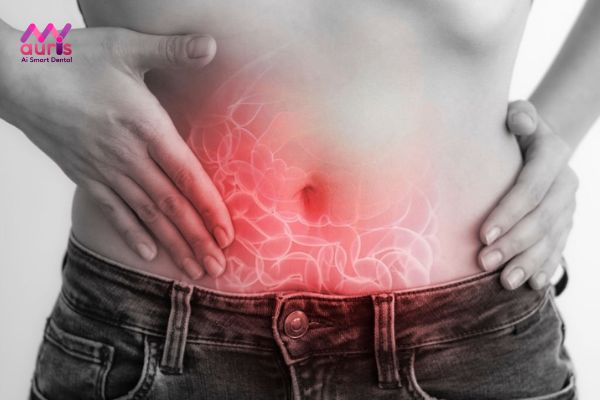Which side of the appendix hurts is a question of identifying warning signs that your appendix health is having problems. And whether this phenomenon causes pain on the left or right side is also of concern to many people. If the disease is not detected and treated promptly, it will be life-threatening. So let’s find out which side of the appendix hurts will determine the treatment of your disease.
Which side of appendicitis pain is an issue that many people are concerned about, but first you need to find out what the appendix is to have the best overview. The appendix is considered a part of the human digestive tract, the base of the appendix flows into the cecum 3cm below the ileocecal angle. The appendix is shaped like a finger, with a diameter of about 0.5 to 1cm and in adults it is about 3 to 13cm long.
The location of the appendix is usually in the lower abdomen on the right side, however, the appendix has a mesentery and is mobile so it can be located in many other locations such as: Right under the liver, middle. The abdominal cavity is often located between the loops of the small intestine or, more rarely, on the left side of the lower abdomen.
In terms of function, previously the appendix was only recognized as a non-functional organ. But now, with the remarkable advances of modern medicine, experts believe that it has the function of producing Globulin antibodies to help strengthen the immune system. Besides, the mucosa also contains many beneficial bacteria for the digestive system. This is also an extremely important function of the appendix for the human body, so when you have pain, you need to clearly determine which side of the appendix you have pain from the doctor’s diagnosis in order to find timely treatment to avoid unnecessary complications later.
What is appendicitis?
After learning the location to know which side the appendix hurts, it has a sac-shaped structure, only as big as a thumb. Appendicitis occurs when there is a blockage inside the appendix, waste reaches the large intestine and accumulates, creating conditions for bacteria to multiply, causing infection and inflammation. This is the cause of appendicitis pain, and the main symptom is severe appendicitis.
Any person of any age can experience appendicitis because this is not a rare disease. The disease is considered quite dangerous for the body, seriously affecting all daily activities of the patient. But the signs of appendicitis or signs of the disease are not clear, especially in the early stages of the disease. Therefore, correctly determining which side of the appendix has appendicitis will help you detect the disease earlier, thereby providing appropriate treatment.

Some signs to answer the question “Which side of the abdomen is appendicitis pain?”
Appendicitis will have many different forms, the typical form is seen in the vast majority of cases when the appendix is in its correct position. Below are the signs to recognize which side of appendicitis pain.
- Symptoms of random abdominal pain often appear, starting from many different locations in the abdomen, lasting from 1 to 3 hours and then localized to the right iliac fossa.
- Continuous abdominal pain, persistent dull pain and gradually increasing pain level
- Within 24 hours, the severity of appendicitis will increase.
In some other positions
- Post-colon appendicitis: Pain in the lumbar region right, there are signs of spreading to the right hip and thigh
- Appendix pain in some other locations
All daily activities of people with appendicitis will be greatly disrupted, because just the person Even small movements that affect the abdomen can cause the patient to feel severe pain. Daily activities such as walking, carrying furniture, walking, etc. will also cause severe pain, so when there are signs of the disease, it is necessary to determine whether you have appendicitis or which side of the appendix you have. For this disease, the patient needs to go to the hospital immediately to be diagnosed by a gastroenterologist and given timely treatment Redundancy is considered a surgical emergency. If the disease is detected early, treatment will be easier. If the patient is subjective, if left untreated for a long time, it can lead to dangerous health complications later and even affect life.
Patients have signs of frequent urination
Bladder pain and frequent urination are also warning signs that appendicitis is showing signs of getting worse. Causesn is due to inflammation and infection from the appendix, affecting the body’s normal excretion process. Therefore, it is necessary to determine the exact location of appendicitis and if this condition lasts long and there is no treatment, it will cause unnecessary and dangerous complications.
Patients have prolonged vomiting accompanied by stomach rumbling signs
Discomfort, diarrhea, abdominal pain, stomach rumbling accompanied by vomiting,… are signs to recognize digestive disorders, in addition, these signs are also used to diagnose appendicitis and lateral appendicitis. come on. In addition to having to endure severe pain in the right appendix, the patient also has to face consequences from the digestive system such as: The body is sick, pale and physically weak. fever
Signs of mild fever, temperature usually ranges from 38 to 38.5 degrees Celsius, accompanied by chills and shaking are also signs of appendicitis. These signs originate from inflammation and infection in the body and the body reacts to inflammation, causing pain locally or throughout the body, typically the two phenomena of the body being fever and shaking.
The patient is bored. eat
Patients who are experiencing digestive problems will usually not intend to add anything to their body. Especially for people with appendicitis, the pain is an obsession and frequent vomiting makes the patient feel afraid to eat, afraid of the feeling of eating and vomiting at any time.
The abdominal wall is contracted. stiffness
The patient’s state of abdominal wall stiffness is also one of the typical signs of appendicitis. Patients need to undergo a number of tests including: X-rays of the abdomen and chest, urine tests, and CT scans to diagnose the disease most accurately if suspected of being confused with stomach pain.

The following are a few signs to help you recognize which side of the abdomen you have appendicitis pain. You need to go to the nearest hospital immediately if one of the above signs appears, do not be subjective because the disease can seriously affect your health.
Treatment methodsTreating appendicitis
Go to the hospital to determine which side of the appendix is painful and perform appendectomy, which is the most common method performed today. And the laparoscopic appendectomy method is considered to ensure high aesthetics and the post-operative recovery will be faster than the conventional surgical method.
After surgery, the patient will be given painkillers and antibiotics to fight inflammation and infection, prescribed rehydration,…
After leaving the hospital, you should note some of the following symptoms and immediately notify your doctor for timely resolution:
- Severe abdominal pain
- Dizziness, lightheadedness
- Uncontrolled vomiting
- Fever
From this article My Auris hopes to provide you with information about appendicitis on which side. You need to pay attention to some of the symptoms of the disease so you can prevent it promptly and go to the nearest medical facility for treatment. Please contact us immediately if you have any questions.
Yen Nhi





